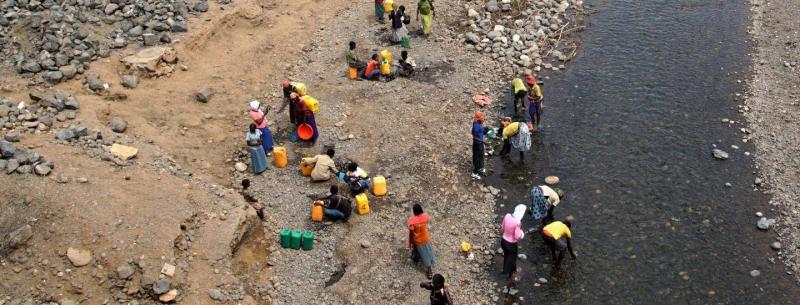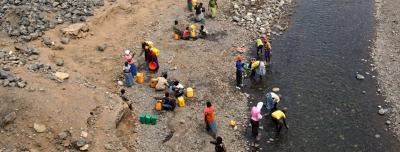A quarter of the world's population, in approximately 25 countries, is facing extremely high water stress. Although water covers 70 percent of our planet, only 3 percent is freshwater available for consumption, of which two-thirds is trapped in frozen glaciers. With the scarcity of freshwater, communities often struggle to meet their needs, either due to a lack of clean water or inadequate infrastructure, as billions of people worldwide face water stress issues. The scarcity of clean water and climate change exacerbate the problem, necessitating the search for more innovative ways to address this phenomenon. This issue is further amplified in agriculture, which needs about 70 percent of the available freshwater each year amid growing population figures.
When discussing water scarcity, five countries in the Mediterranean are the most susceptible to water stress: Bahrain, Cyprus, Kuwait, Lebanon, and Oman. Since most of these countries are in the Arab region, the matter undoubtedly concerns us more than others, as our resources are abundant but investment opportunities are scarce. The "World Resources Institute" has launched a campaign to shed light on what water stress entails through a report prepared by Samantha Kuzma, Liz Sacochia, and Marlena Chertok, stemming from the core issue: it is a problem that affects a quarter of the global population.
The institute relied on data and interactive maps from a groundwater atlas project in 25 countries, all of which face extremely high water pressure each year and regularly consume almost all of their available water supplies. At least 50 percent of the world's population—around 4 billion people—live under conditions of severe water stress for at least one month of the year. Coexisting with this level of water stress endangers people's lives, livelihoods, food security, and energy security, especially since water is essential for crop farming, livestock, electricity production, maintaining human health, promoting equitable communities, and achieving global climate goals. Without better water management, population growth, economic development, and climate change will further exacerbate water stress. Here, we delve into the causes of increasing water stress—and the countries and regions that will be most affected.
**What Causes Global Water Stress?**
Globally, the demand for water exceeds the available supply. Demand has doubled since 1960 and is often on the rise due to expanding populations and industries, such as irrigated agriculture, livestock, energy production, and manufacturing. At the same time, a lack of investment in water infrastructure, unsustainable water use policies, or increasing variability due to climate change can affect the available water supply. Water stress measures the ratio of water demand to renewable supply by competing for local water resources. The smaller the gap between supply and demand, the more prone the area is to water scarcity. For instance, a country facing "severe water stress" uses at least 80 percent of its available water supply, while "high water stress" indicates a withdrawal of 40 percent of its supply. Without intervention—such as investment in water infrastructure and improved water management—water stress will continue to worsen, especially in places with rapid population growth and economies.
**Which Countries Face the Worst Water Stress?**
Data from the atlas reviewed by the institute indicates that 25 countries are currently experiencing extremely high annual water stress, meaning they use over 80 percent of their renewable water supplies for irrigation, livestock, industry, and domestic needs. Even short-term droughts expose these areas to the risk of running out of water and sometimes prompt governments to shut off taps. We have already seen this scenario implemented in many places worldwide, including England, India, Iran, Mexico, and South Africa. The five countries facing the most significant water stress are Bahrain, Cyprus, Kuwait, Lebanon, and Oman. This stress in those countries mainly arises from low supply, coupled with demand from domestic, agricultural, and industrial use.
The regions suffering the most from water stress are the Middle East and North Africa, where 83 percent of the population faces extremely high water stress, with the figure dropping to 74 percent in South Asia. The situation is poised to worsen; by 2050, an additional billion people are expected to live under conditions of extremely high water stress, even if the world endeavors to limit global temperature rise to 1.3 degrees Celsius from a previous forecast of 2.4 degrees Celsius by 2100, a rather optimistic scenario.
Global water demand is expected to increase by 20 to 25 percent by 2050, while fluctuations year-on-year are anticipated to rise by 19 percent. For the Middle East and North Africa, this indicates that 100 percent of the population will live under extremely high water stress by 2050. This issue does not only pertain to water-dependent consumers and industries but extends to political stability. For instance, in Iran, decades of mismanagement and unsustainable agricultural practices have led to protests exacerbated by increasing water stress.
**Water Demand in Africa**
The most significant change in water demand from now until 2050 is expected to occur in the Sub-Saharan African region. While most countries there currently do not suffer from severe water stress, demand is growing faster in this area than in any other part of the world. By 2050, water demand is projected to rise by 163 percent—four times the rate of change anticipated in Latin America, which is expected to see a 43 percent increase in water demand.
This rise in water use, primarily anticipated for irrigation and household supplies, could drive significant economic growth in Africa—projected to be the fastest-growing economic region in the world. However, ineffective water use and unsustainable management also threaten to reduce the region's GDP by 6 percent.
**North America and Europe**
Meanwhile, water demand remains stable in the wealthier countries of North America and Europe. Investments in water conservation have helped reduce usage within high-income nations, but water usage and reliance extend beyond national borders, with increasing contributions from water embedded in international trade from low-to-middle-income countries to high-income nations.
According to "Aqueduct" data, up to 24 percent of global GDP—70 trillion USD—will be under high water stress by 2050, marking an increase of approximately 15 trillion USD (24 percent of global GDP) from 2010. Four countries alone—India, Mexico, Egypt, and Turkey—will account for more than half of the exposed GDP by 2050. Water shortages can lead to industrial disruptions, power outages, and agricultural production losses, as witnessed in India, where cooling shortages at thermal power stations from 2017 to 2021 led to a loss of 8.2 terawatt-hours of energy—enough electricity to power 1.5 million Indian households for five years. Failure to implement better water management policies could lead to GDP losses of 7 to 12 percent in India, China, and Central Asia, and around 6 percent across much of Africa by 2050, according to the Global Commission on Adaptation.
**Food Security**
Global food security is undoubtedly at risk. Already, 60 percent of irrigated agriculture worldwide faces extremely high water stress—particularly sugarcane, wheat, rice, and maize. However, to feed an expected 10 billion people by 2050, the world will need to produce 56 percent more nutritional calories than in 2010—all while dealing with increasing water stress and climate-related disasters such as droughts and floods.
**Better Management for a Water-Secure Future**
While it is essential to understand the state of water supply and demand globally, water stress does not necessarily lead to a water crisis. For example, places like Singapore and Las Vegas demonstrate that communities can thrive even under the most water-scarce conditions through the use of technologies such as replacing water-thirsty lawns, desalination, and wastewater treatment and reuse.
In fact, research shows that solving global water challenges costs less than one might think, costing the world about 1 percent of global GDP, or 29 cents per person each day from 2015 to 2030. What is lacking is the political will and financial support to seek effective, cost-efficient solutions. Some of the key ways to improve water management and reduce water stress include: countries can enhance their water management practices, stimulate water use efficiency in agriculture, adopt integrated water resource management, and enhance water infrastructure through nature-based solutions and green infrastructure. Protecting and restoring wetlands, mangroves, and forests not only improves water quality and builds resilience to droughts and floods but also saves money spent on water treatment costs.
International development banks and other lenders should consider strategic debt relief programs, such as nature debt swaps or debt relief in exchange for commitments to invest in biodiversity or resilient infrastructure, restoring mangroves, or conserving wetlands. These nature-based solutions can yield positive climate and water outcomes in countries unable to afford improved water management on their own.
Policy-makers in water-stressed countries should prioritize wise energy sources in water management, such as solar and wind energy, to avoid power outages due to water shortages. Cities should also develop water-resilient action plans in urban areas, learning from six African cities that are already experimenting with such methods. Treating and reusing wastewater can also create new water sources for cities.
Farmers should adopt more water-efficient measures, such as switching to drought-resistant crops or utilizing methods like sprinkler or drip irrigation instead of flood irrigation. Companies need to set science-based water targets that align with what science indicates is "sufficient" to stay within planetary boundaries and meet community needs, learning from an increasing number of companies that have already set such targets.
Governments, as well as communities and companies, must step forward to build a water-secure future for all. Ultimately, the world will require a comprehensive approach encompassing all of the above, in addition to solutions tailored to specific watersheds and individual regions. These outcomes may seem daunting, but with the right management, every country can prevent water stress from turning into a full-blown water crisis.




